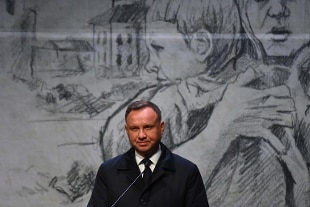Andrzej Duda, archive image (Ansa)
Share
September 17, 2021 With the tolling of the bell, the first Memorial of the deportations to Siberia was inaugurated today in Białystok, in eastern Poland, to remember the dramatic stories of the people forced to leave their homes due to the Molotov-Ribbentrop pact between Stalinist USSR and Nazi Germany of 1939, with which Poland was occupied for several years by the two neighboring countries.
"I express the utmost respect for all those who have suffered as a result of forced exile and for those who have not survived," said the head of state Andrzej Duda, present at the ceremony, together with his predecessor, former president Bronisław Komorowski, and to the local mayor, Tadeusz Truskolaski, who started building the museum ten years ago.
Among the guests of honor, came from Naples Marta Herling, of the Italian Institute for Historical Studies, niece of Benedetto Croce and daughter of the Polish writer Gustav Herling-Grudzinski, who wrote her memoirs from Siberia in the book "Il mondo a part". Memories "considered uncomfortable" in the post-war period by Western publishers and known to the wider public, including Italian, only from the beginning of the nineties.
Marta Herling recalled that in Białystok there was the first stop on the train that took her father to the Gulag. A journey that usually lasted 4-6 weeks and that touched on about
330,000 people, 40,000 of whom have never returned. The new Memorial is located in one of the pre-war military buildings directly adjacent to the railway track - with a strong symbolic value - from which in 1940-1941 and 1944 the Soviets loaded the deportees to Siberia on cattle carts.
Also from the same building, in 1943, the Germans deported Jews from the Białystok ghetto to the Treblinka concentration camp.

